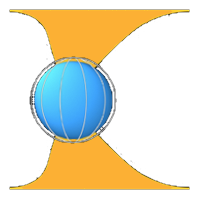 |

You must be logged in to download files
Please login or register using the form at the top right of the page
The security code was invalid
Please re-enter the security code and try again
AMPERE Virtual Geomagnetic Observatory (VGO) data are derived estimates of the departures of the Earth's magnetic field at 780 km altitude relative to the International Geophysical Reference Field, generation 11 (IGRF-11, Finlay et al., 2010) magnetic field reference model. VGO estimates were derived from Iridium Block-1 satellite magnetic field observations as described in Anderson et al. (2021), which should be studied before using this high-level dataset.
These results do not preserve the magnitude of the main field as the data processing applies an inter-calibration of the observations against IGRF-11. Apart from this calibration scale factor, the VGO data reflects the true geometry of the geomagnetic field.
Dates for which VGO data are provided span from January 2010 to December 2016 in a non-monotonic fashion. These dates were selected to be the quietest set of days within each month and quarter as described in Anderson et al. (2021).
VGO data file contents:
When using these data for publications of research analysis, please cite Anderson et al. (2021) and follow the Rules of the Road guidelines for AMPERE data products.